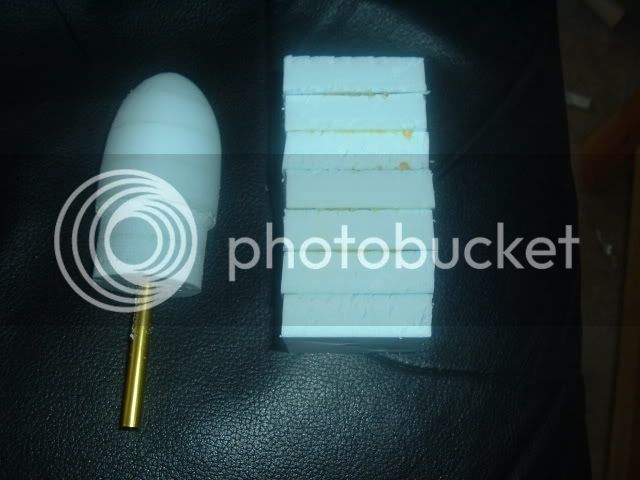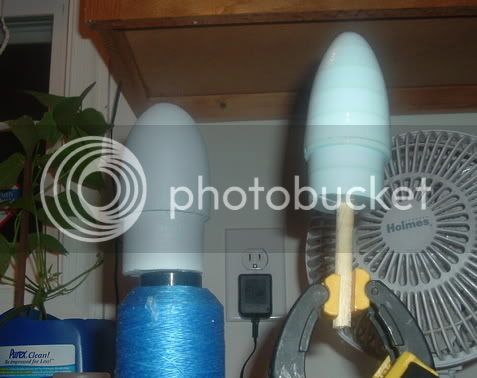plasticpaul
Well-Known Member
- Joined
- Jun 27, 2006
- Messages
- 1,145
- Reaction score
- 0
If this has been discussed recently I appologize.
Since I like to roll my own tubes and basically build everyhting from scratch I have been playing around with different ways of making a nice cone. I believe what I am currently doing is ideal. I am not sure if this is an original idea or not but I wanted to share what I am doing.
I am using the sheet foam you can get at the home improvement store. I am using the foam but the fink will work as well. Cut a bunch of sqaures a little larger than the OD of your tube. You need enough squares so that when you stack then they are at least as tall as the cone you want plus the shoulder.
I use Spray Adhesive from 3M to bond them together but you could use any glue that will not eat the foam (check this). Bond your stack together and let it sit for a bit to set up well.
Once that is set up pretty good you will need to glue a dowel into the center of one end of your stack/blank. For smaller cones a 1/4" dowel is fine. I am doing a bigger cone right now (over 3") and I have glued in a 1/2" dowel. There are a couple of wayd to get the dowel fixed in the block. I would heat up a bolt or something similar and melt a hole down into the block. You can then either hot glue or epoxy your dowel into the block. The hot glue will melt into the block a little bit but that's okay.
Now it's time to start shaping your cone. I use a wood rasp for my rough shaping. If you don't have a wood rasp course sand paper glued to a wood block will work well.
I do mine by holding my drill in one hand and shaping with the other hand but if you have done a great deal of wood turning I would suggest clamping your drill to a solid surface. Shape your blank into a relatively round piece beofre you focus on any one area. I like to reduce the diameter on the tip (part away from the drill) rather quickly to reduce vibration.
Now that your blank is pretty round go ahead and shape the shoulder. Once you think you are close check it frequently. Once it is close, finish it with 220 sand paper. Once you have the should to where you want it go ahead and shape the rest.
When you have the cone you want take it off the drill and dip in or paint it with epoxy. This is to fill the poors of the foam and give you a nice hard surface so you can get a nice finish. It also protects the foam from any finishes you may want to use including primer, because they may eat the foam.
If you want a really hard cone do the epoxt thing more than once but make your original turning slightly small because the epoxy will add size. Once you are done with the epoxy and all finishing cut off the dowel and put a screw eye in there to hold your shock cord.
I will post some pics when I get a chance but I can tell you it is real easy to make nice nose cones for pennies. I paid something like 10 or 11 dollars for a 1/2" 4'x8' sheet of foam.
Since I like to roll my own tubes and basically build everyhting from scratch I have been playing around with different ways of making a nice cone. I believe what I am currently doing is ideal. I am not sure if this is an original idea or not but I wanted to share what I am doing.
I am using the sheet foam you can get at the home improvement store. I am using the foam but the fink will work as well. Cut a bunch of sqaures a little larger than the OD of your tube. You need enough squares so that when you stack then they are at least as tall as the cone you want plus the shoulder.
I use Spray Adhesive from 3M to bond them together but you could use any glue that will not eat the foam (check this). Bond your stack together and let it sit for a bit to set up well.
Once that is set up pretty good you will need to glue a dowel into the center of one end of your stack/blank. For smaller cones a 1/4" dowel is fine. I am doing a bigger cone right now (over 3") and I have glued in a 1/2" dowel. There are a couple of wayd to get the dowel fixed in the block. I would heat up a bolt or something similar and melt a hole down into the block. You can then either hot glue or epoxy your dowel into the block. The hot glue will melt into the block a little bit but that's okay.
Now it's time to start shaping your cone. I use a wood rasp for my rough shaping. If you don't have a wood rasp course sand paper glued to a wood block will work well.
I do mine by holding my drill in one hand and shaping with the other hand but if you have done a great deal of wood turning I would suggest clamping your drill to a solid surface. Shape your blank into a relatively round piece beofre you focus on any one area. I like to reduce the diameter on the tip (part away from the drill) rather quickly to reduce vibration.
Now that your blank is pretty round go ahead and shape the shoulder. Once you think you are close check it frequently. Once it is close, finish it with 220 sand paper. Once you have the should to where you want it go ahead and shape the rest.
When you have the cone you want take it off the drill and dip in or paint it with epoxy. This is to fill the poors of the foam and give you a nice hard surface so you can get a nice finish. It also protects the foam from any finishes you may want to use including primer, because they may eat the foam.
If you want a really hard cone do the epoxt thing more than once but make your original turning slightly small because the epoxy will add size. Once you are done with the epoxy and all finishing cut off the dowel and put a screw eye in there to hold your shock cord.
I will post some pics when I get a chance but I can tell you it is real easy to make nice nose cones for pennies. I paid something like 10 or 11 dollars for a 1/2" 4'x8' sheet of foam.







